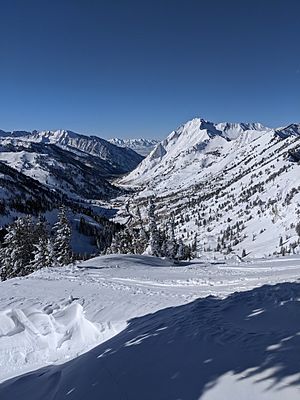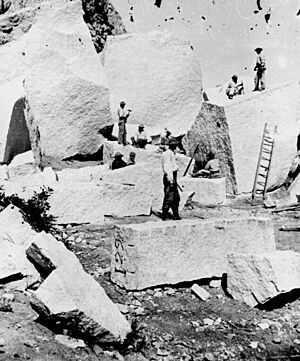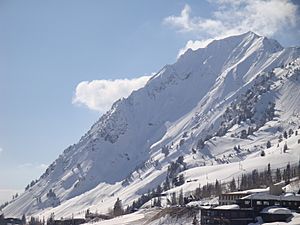Little Cottonwood Canyon facts for kids
Little Cottonwood Canyon is a beautiful valley in Utah, not far from Salt Lake City. It is part of the Wasatch-Cache National Forest, located on the eastern side of the Salt Lake Valley. This canyon looks like a giant "U" shape because it was carved by a huge river of ice, called an alpine glacier, many thousands of years ago. You can find special plants here that don't grow anywhere else, and Mountain goats live in the nearby mountains.
Long ago, pioneers used strong rocks like granite from this canyon to build the famous Salt Lake Temple. Today, a road called State Route 210 goes all the way up the canyon. A creek named Little Cottonwood Creek flows through the canyon, starting at Cecret Lake near Alta.
Contents
How the Canyon Was Formed
The rocks in Little Cottonwood Canyon are very old, about 29 to 30 million years old! Most of them are a type of rock similar to granite. These rocks were formed deep underground when hot, melted rock pushed its way up.
Sometimes, you can see interesting features in these rocks. These include porphyry (rocks with larger crystals in a fine-grained base) and "pebble dikes." Pebble dikes are like thin walls of rock made of small, rounded pebbles. These features show how the rocks changed over time.
The canyon's geology also played a role in a huge landslide that happened nearby. The types of rocks and the steep slopes helped cause this big slide.
Fun Things to Do in the Canyon
Little Cottonwood Canyon is a great place for outdoor adventures! You can go hiking, camping, fishing, mountain biking, rock climbing, and bouldering. In winter, it's perfect for skiing and snowboarding.
There are two popular resorts in the canyon: Alta and Snowbird. They offer fun activities all year round. If you love wildflowers, the Utah Native Plant Society often leads walks to see them, especially in Albion Basin. The road up the canyon is also a popular challenge for bike riders because it's quite steep!
Skiing and Snowboarding Fun
Little Cottonwood Canyon is famous for its amazing snow! It's home to two ski resorts, Snowbird and Alta. Alta gets about 550 inches of snow each year, which is a lot!
The canyon is also well-known for backcountry skiing. This means skiing in areas outside of the marked ski resorts. There are hundreds of named backcountry runs, including on a big mountain called Mount Superior.
Rock Climbing Adventures
The lower part of the canyon has many large rock formations. These are mostly smooth, steep faces made of strong rock, similar to granite. Some of these rock faces are hundreds of feet tall!
People have been climbing here since the 1930s. Many famous climbers have explored the routes in Little Cottonwood Canyon. Today, climbers continue to push their skills on these challenging rocks.
One popular spot is called The Fin. It has routes like The Dorsal Fin, which is a classic climb. Another well-known area is Gate Buttress, with over 80 different climbing routes. Near the road, you'll find the Gate Boulder, a favorite spot for climbers to gather.
The Pfeifferhorn is one of the highest peaks in the Wasatch Mountains that climbers like to conquer. It's a long climb, but the views from the top are amazing!
Little Cottonwood Canyon also has many bouldering routes. Bouldering is a type of climbing done on smaller rocks, usually without ropes. There are over 500 bouldering routes here, with different levels of difficulty. Some popular bouldering areas include Secret Garden, 5 Mile, and White Pine.
Images for kids
-
View of Salt Lake Valley from Hidden Peak summit
-
Quaking Aspens trees
-
Albion Basin Wildflowers
-
Xenoliths (pieces of other rocks) inside the main rock of the canyon










